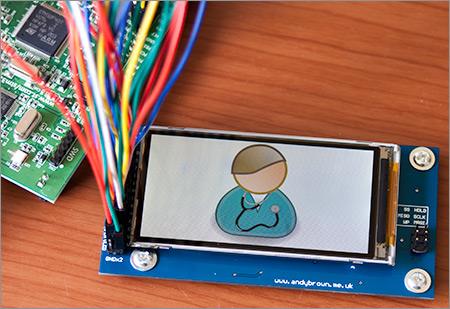
[Andy] has done a great job reverse engineering the LG KF700 cell phone display. LG’s KF700 is a 2008 era cell phone — that’s about 300 years old in cell phone years. The phone was somewhat novel in that it used a 3” diagonal 2:1 480×240 widescreen format. While the phone itself may be a memory, its screen lives on through the magic of Ebay.
Obtaining the LCD is the easy part – the hard part is figuring out how to interface to it. LG is very helpful in that regard by publishing detailed service manuals and schematics on their cell phones. We’re not sure if these manuals are supposed to be public domain, but Google is your friend here. With the help of the service manual, [Andy] was able to determine the LCD has an on board controller (Himax HX8352), making it much easier to interface to. He was also able to find out information about the LCD connector pin out, and even a connector part number.
Connectors in hand, [Andy] set about building a board. His software of choice is Protel, former name of the software we now know as Atlium designer. Knowing that most people aren’t running the same software he is, [Andy] gives plenty of information on creating a footprint for the tiny LCD connector.
The last part of this hack was the software. [Andy] is fond of the STM32 series, so he started with drivers for those processors. The final product is quite impressive. [Andy] also ported his driver to the Arduino Mega, however a 5 volt to 3.3 volt adapter must be used between the Arduino and the LCD. Software for both drivers are available on [Andy’s] github.















Did somebody accidentally the CSS? I’m getting white backgrounds on the articles and the comments in Firefox.
Chrome looks fine, Firefox has the white issue. Could be css or something to do with firefox.
I’m using chrome, and it doesn’t look good
Chrome looked good in 15 or so minutes ago, only Firefox had this white background CSS problem… now Chrome is also messed up.
Same here with iceweasel. Looks like HaD just wrecked the CSS for good.
Relevant: http://thecodinglove.com/post/60946709632/when-i-change-the-css
Also getting these white backgrounds on chrome Version 30.0.1599.69 m on Windows 7.
Thanks for pointing this out. It renders fine for me on Chrome, but Firefox is a white/white nightmare. I’ll take a look at what’s gone wrong.
I just hit CTRL-A and can read. And it’s a hack!
Site looks terrible – sorry to tell ya, but the content width is messed up (too slim, awkwardly large gap between content and the ads/navigation/archive column), text is white on white background and has to be highlighted to be read. Broken in Chrome, FireFox, and IE.
Who is to blaim for this new white on white layout?
blaim? Is that an English word?
Holy I can’t see anything I am blind! Everything is white!!
Yeah CSS is messed up for Firefox (and Chrome for me). The style.css file isn’t shown in the raw source, so I figure there’s Javascript somewhere that’s loading the /wp-content/themes/premium/genesis/style.css file.
(erm, as this is the file that appears to contain the white background: li.comment line 113 in /wp-content/themes/premium/genesis/style.css)
Chrome is also white…. Global disaster! :D
Now, on the topic…
I’ve read the article, and I have to congratulate the author. Well done research, well done PCB and well written article.
This would be a nice addition to a RasPi on my car. Fit a touchscreen on top of that, and you get a nice screen.
Sadly, I am sure that I cannot replicate its work…
He’s got boards for sale, you don’t need to replicate it.
Wow, I had to double check which website I was reading. Haven’t seen a Hackaday writeup so well done. I’m talking about the Hackaday summary here and I’m being entirely sincere. I hope this Adam guy is sticking around for a while.
Aww shucks, thanks! Glad you’re enjoying it. I’m definitely having a lot of fun writing.
Andy Brown is a great guy and it’s really a shame that an article of this fine quality is diminished by so many off-topic posts.
You would think that people would leave such comments under “leave a tip” because informing the webmaster of broken content IS “leaving a tip”.
You’re absolutely right on both points. Andy has some great, well documented projects! I’m just sorry that wordpress borked while his post was at the top of the page.
My favorite thing about Andy is that he has no fetish for Arduino or ARM, he chooses the best tool for the job. His approach is straightforward and rigorous and I think the average hackaday reader would benefit greatly from reading and understanding the articles on his site.
This hack is very clean and straight to the point. Love it.
Interestingly he did reverse engineering the hard way by fuzzing LCD controller and looking at the output instead of capturing real data between lcd and a phone, even though he has a nice 1GHz logic analyzer.
Has anyone done a reverse engineering for Samsung (super)Amoled LCD such as that used in i9300,i9305 ( S3) or similar?
Andy u rock….building up ya things…That`s my next project I think the best way to do it hook up the electronics together and try to figure out why its not working, and that is what im gonna do.